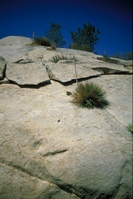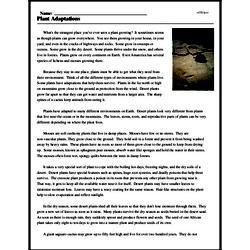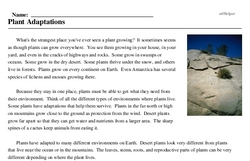Plant Adaptations
What's the strangest place you've ever seen a plant growing? It sometimes seems as though plants can grow everywhere. You see them growing in your house, in your yard, and even in the cracks of highways and rocks. Some grow in swamps or oceans. Some grow in the dry desert. Some plants thrive under the snow, and others live in forests. Plants grow on every continent on Earth. Even Antarctica has several species of lichens and mosses growing there.
Because they stay in one place, plants must be able to get what they need from their environment. Think of all the different types of environments where plants live. Some plants have adaptations that help them survive. Plants in the far north or high on mountains grow close to the ground as protection from the wind. Desert plants grow far apart so that they can get water and nutrients from a larger area. The sharp spines of a cactus keep animals from eating it.
Plants have adapted to many different environments on Earth. Desert plants look very different from plants that live near the ocean or in the mountains. The leaves, stems, roots, and reproductive parts of plants can be very different depending on where the plant lives.
Mosses are soft cushiony plants that live in damp places. Mosses have few or no stems. They are non-vascular plants. They grow close to the ground. They hold soil in a forest and prevent it from being washed away by heavy rains. These plants have no roots so most of them grow close to the ground to keep from drying up. Some mosses, known as sphagnum peat mosses, absorb water like sponges and hold the water in their stems. The mosses often form wet, spongy quilts between the trees in damp forests.
It takes a very special sort of plant to cope with the boiling hot days, freezing nights, and the dry soils of a desert. Desert plants have special features such as spines, huge root systems, and deadly poisons that help them survive. The creosote plant produces a poison in its roots that prevents any other plant from growing near it. That way, it gets to keep all the available water near it for itself. Desert plants may have smaller leaves to minimize moisture loss. Leaves may have a waxy coating for the same reason. Hair-like structures on the plant help to slow evaporation and reflect sunlight.




